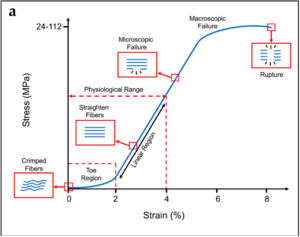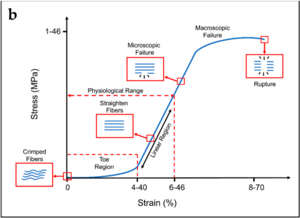◔
Lumbar Spine Biomechanics: Difference between revisions
From WikiMSK
No edit summary |
|||
| Line 41: | Line 41: | ||
*With sufficient force, the bonds can break, causing the collagen fibre to '''fail''' with it ceasing to resist elongation | *With sufficient force, the bonds can break, causing the collagen fibre to '''fail''' with it ceasing to resist elongation | ||
**After failure, only small forces are required to tear apart the unbonded component fibrils and molecules. | **After failure, only small forces are required to tear apart the unbonded component fibrils and molecules. | ||
===Stress-strain curve=== | |||
*Three main regions | |||
**First region is the ''toe'' phase. This is where the crimp is being removed from the collagen fibre | **First region is the ''toe'' phase. This is where the crimp is being removed from the collagen fibre | ||
**The second, linear region is the steep slope along the middle of the curve, and is where the stress stretches the collagen fibre longitudinally and the crimp has been removed. The bonds within and between the collagen fibrils are being strained and some are being broken. The peak is the phase of failure of the collagen fibre, with substantial numbers of bonds being irreversibly broken. | **The second, linear region is the steep slope along the middle of the curve, and is where the stress stretches the collagen fibre longitudinally and the crimp has been removed. The bonds within and between the collagen fibrils are being strained and some are being broken. The peak is the phase of failure of the collagen fibre, with substantial numbers of bonds being irreversibly broken. | ||
**The last part of the curve is once failure has occurred, and elongation occurs with ever decreasing amounts of stress Collagen fibrils start to be strained and broken somewhere after 3% and 4% of elongation of the fibre. About 4% is the maximum a fibre can sustain without risking microscopic damage. | **The last part of the curve is once failure has occurred, and elongation occurs with ever decreasing amounts of stress Collagen fibrils start to be strained and broken somewhere after 3% and 4% of elongation of the fibre. About 4% is the maximum a fibre can sustain without risking microscopic damage. | ||
==Stiffness== | ==Stiffness== | ||
Revision as of 07:50, 11 May 2021
This article is a stub.
Movements
| Movement | Description | Movement occurs when | Force |
|---|---|---|---|
| Translation | Every point on a bone moving in the same direction and to the same extent | Single force or net single force acts on a bone | Shear force |
| Rotation | All the points on a bone move in parallel around a curved path that is centred on a fixed point, but to different extents depending on their distance from the centre of rotation. May be due to two opposed muscular actions, or muscular action and ligamentous resistance, or gravity opposed by either muscular action or ligamentous resistance. | Two unaligned forces acting in opposing directions on different parts of the bone forming a force couple | Torque |
- Axis of rotation
- Formal definition = that region that does not move when two or more opposing, unaligned forces act on a bone.
- With rotation of a bone, all the points on the bone can be grouped into individual planes that lie parallel to the direction of movement.
- In each plane, the points move about a centre located in that plane
- When all the centres of all the planes line up they depict a straight line forming the axis of rotation of the bone.
- It is a region where all opposing forces cancel out, and there is no net force acting, and so it stays stationary.
- Different forces create different axes of rotation.
Planes of Movement
Stress-Strain

Typical stress–strain curve and schematization of the behavior of the collagen fibers for tendons. Typical ranges of stress and strain are indicated on the x and y axes.[1]

Typical stress–strain curve and schematization of the behavior of the collagen fibers for ligaments.[1]
- With stretching of a collagen fibre, the fibre resists elongation due to a resistance force from the chemical bonds between the collagen fibrils, between tropocollagen molecules, between collagen fibres, and between collagen fibres and proteoglycans.
- Stress = the applied elongating force, measured in units of force (newtons)
- Strain = the extent to which a fibre is elongated, measured as the fractional or percentage increase in length relative to the initial length.
- A fibre of length L0 when stretched to a new length L1 undergoes a strain of L1/L0 x 100%
- Tension strain = this occurs with a deforming force causing a structure to be stretched longitudinally
- Compression strain = this occurs with a deforming force causing a structure to be squashed
- Measured as the fractional or percentage decrease in height of a structure
- Shear force = forces that cause two vertebrae to slides with respect to one another
- Shear strain = the strain that occurs in the intervening intervertebral disc
- Shear vs tension: tension conventionally applies to forces that are exerted along the long axis of a structure. Shear forces are applied across the axis.
- Torsion = when an object twists, the force is a torque, and the resultant strain is a torsion strain.
- Crimp = At rest, single collagen fibres are usually buckled, the wavy shape is called crimp
- With the application of stress, the first effect is straightening of the crimp, and this requires little energy due to no major chemical bonds
- Once crimp has been removed, the collagen fibre resists strongly against further elongation
- The stress attempts to break the bonds between the collagen fibrils and tropocollagen molecules, and so more force is required for further elongation.
- With sufficient force, the bonds can break, causing the collagen fibre to fail with it ceasing to resist elongation
- After failure, only small forces are required to tear apart the unbonded component fibrils and molecules.
Stress-strain curve
- Three main regions
- First region is the toe phase. This is where the crimp is being removed from the collagen fibre
- The second, linear region is the steep slope along the middle of the curve, and is where the stress stretches the collagen fibre longitudinally and the crimp has been removed. The bonds within and between the collagen fibrils are being strained and some are being broken. The peak is the phase of failure of the collagen fibre, with substantial numbers of bonds being irreversibly broken.
- The last part of the curve is once failure has occurred, and elongation occurs with ever decreasing amounts of stress Collagen fibrils start to be strained and broken somewhere after 3% and 4% of elongation of the fibre. About 4% is the maximum a fibre can sustain without risking microscopic damage.
Stiffness
Initial Range of Movement
Creep
Hysteresis
Fatigue Failure
Forces and Moments
References
Literature Review
- Reviews from the last 7 years: review articles, free review articles, systematic reviews, meta-analyses, NCBI Bookshelf
- Articles from all years: PubMed search, Google Scholar search.
- TRIP Database: clinical publications about evidence-based medicine.
- Other Wikis: Radiopaedia, Wikipedia Search, Wikipedia I Feel Lucky, Orthobullets,


